Selco Begovic is a man with an incredible story and an abundance of wisdom to share. Trapped in a city cut off by military blockade during the collapse of the former Soviet Union for over a year, he was forced to adapt to the situation quickly or lose his life. Selco’s journey through the Balkan Wars is a stark reminder of how quickly the threads of society can unravel when the fabric of a nation is torn apart. Raised in the Socialist Federal Republic of Yugoslavia, Selco witnessed the collapse of communism and the ensuing chaos as old tensions — suppressed for decades — erupted into full-scale war.
The transition from a unified Yugoslavia to a fractured region marked by civil war and genocide was swift and brutal, fueled by the resurgence of historical grievances and the manipulation of fear by the media and political elites.
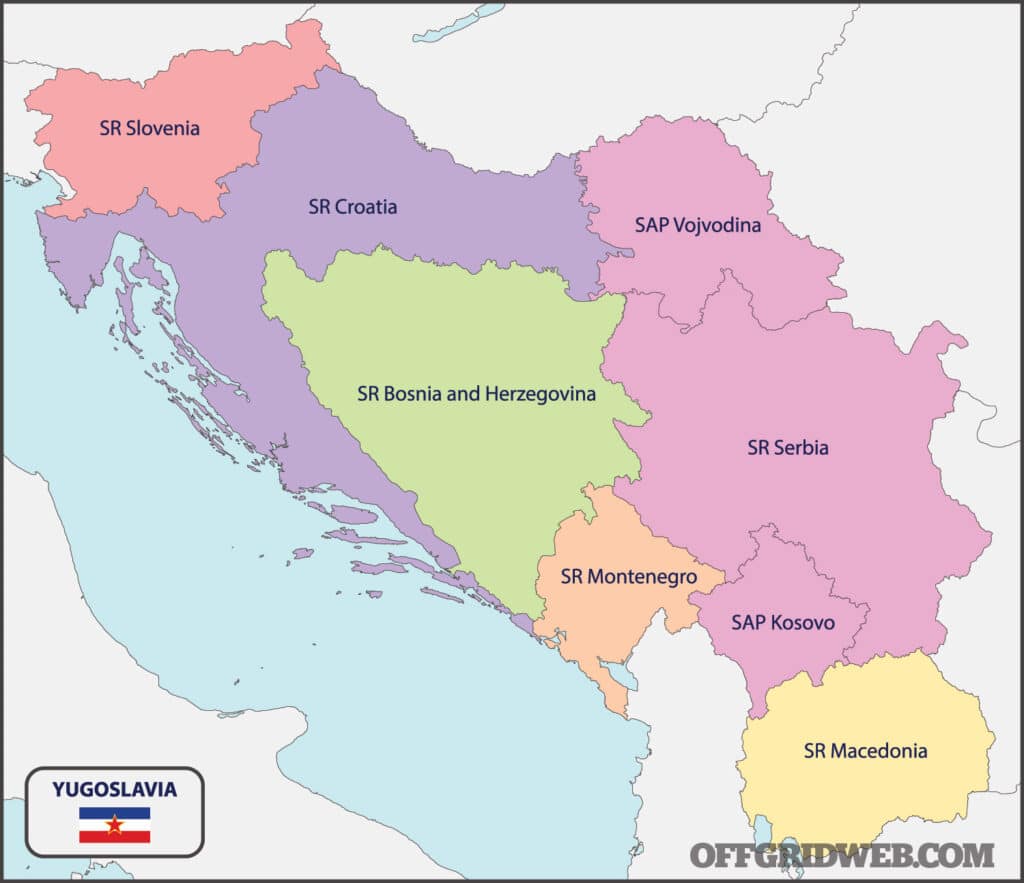
With a constitution modeled after that of the Soviet Union, the Federal People’s Republic of Yugoslavia consisted of six Socialist Republics (SRs) as well as two Socialist Autonomous Provinces (SAPs) within SR Serbia.
As the war approached, Selco observed the ominous signs of societal breakdown — such as economic instability, rising tensions between different ethnic groups, and the disintegration of communal bonds that once held neighbors together. The media, once a source of information, became a tool of propaganda, spreading fear and misinformation that only deepened the divides.
Violence escalated rapidly as people, driven by desperation and a survival instinct, turned on each other, leading to widespread looting, organized crime, and a breakdown of law and order.
If that sounds chillingly similar to present times, then Selco’s words of warning are worth heeding. Thankfully, he’s willing to share his experience with anyone willing to listen, and we spent some time learning how we can be better prepared for the potential of balkanization in the West.
Editor’s Note: Since English is not Begovic’s primary language, we have revised some of the vocabulary and phrasing in his answers for a smoother reading experience.
Interview with Selco Begovic
Editor’s Note: Since English is not Begovic’s primary language, we have revised some of the vocabulary and phrasing in his answers for a smoother reading experience.
Tell us a little about your upbringing. Where were you when these events began to unfold?
Selco Begovic: I was born and raised in the old socialist system in what was then Yugoslavia. It’s a beautiful region and I had a normal life, much like young people in the U.S. or the rest of Europe. I was 18 years old, liked movies, and went to the cinema with girls. I listened to Metallica and played in a heavy metal band.
I witnessed the fall of communism in my country a year or two after the Berlin Wall came down. This transition to “democracy” led to the collapse of Yugoslavia, the formation of new states, and a series of wars in the region. At first, there was hope for a new era of freedom and democracy, but there was also fear of old conflicts resurfacing. In the end, those ghosts of war from the past prevailed.
Some might call me a survival expert. I call myself a survivor. I fought for my life for a year in a city that was surrounded by the enemy army and cut off from power, clean water, and supplies, and under constant attack by snipers and artillery. Gangs ruled the neighborhood, and we had to fight for survival every day and night. The civil war lasted for four years.
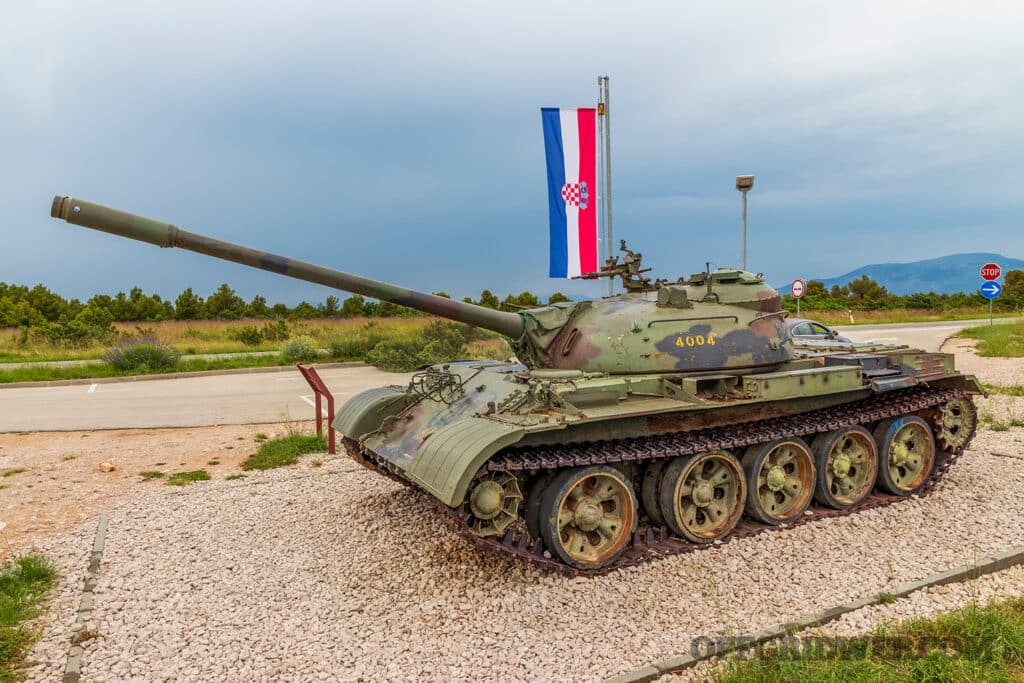
Above: This tank monument commemorates the Croatian War of Independence, which began in 1991 after Croatia declared independence from the Socialist Federal Republic of Yugoslavia.
What were the earliest political or social changes you noticed that signaled the beginning of the conflict?
With the fall of the old socialist/communist system and the introduction of a new one, many people wanted change. Personal freedoms and rights that had been suppressed under communism started to emerge. This region has a long history of conflicts among different ethnicities, religions, and nationalities, and those old tensions were brought to the surface as well.
For years, people were taught that even though we were different, we could come together to build a greater Yugoslav nation, a “melting pot” where our differences would only make us stronger. But when communism fell, those differences were deemed insurmountable, and each group began trying to take territory and resources from one another.
This became a source of division and eventually led to civil war. Our history of conflicts in the past was used to highlight our differences and sharpen the existing hatred.
How did the media portray the rising tensions, and did you notice any bias or manipulation in their reports? How did the media's message change after war began?
This was the 1990s, a time before the internet. People believed what they saw on TV or heard on the radio because they didn’t have the means to quickly verify information. While there were some efforts by the media to calm the situation, these were rare. More often, the media sensationalized events or, even worse, intentionally fueled fear and hatred.
In retrospect, it seems strange what people were willing to believe, but this is a reminder not to underestimate the reactions of those who are under the influence of propaganda. Once the war started, the media fell completely under the control of the ruling powers in each region.
Independent media was virtually non-existent, and it became very dangerous to even attempt to report the truth during those wars.
The first time I heard about war was when I saw a report on local TV that people were fighting in a town in a neighboring state. The media said they were fighting to restore peace. The reality was very different.
I remember the report showed a group of fighters or so-called “rebels” who fought against the official army — about 30 soldiers in front of some tanks and armored vehicles trying to look and act like real soldiers. They acted like they had a cause but looked like a bunch of gang members who just looted the military barracks and stole all the weapons and equipment.
The guy who talked most of the time was wearing a helmet with a badge of the official army, but it was crossed out and he had painted small skulls on top of it. He had a long beard and two knives on his belt. He looked dirty and mean. Other soldiers kept interrupting him with comments about how they “liberated the area” and “freed the people,” but most of them looked drunk or high.
In one of the next parts of the report, they showed the outskirts of the town with corpses lying in the streets. One of them was clearly a postman, still next to his bike, so it was obvious he was shot when he was riding it. There were dead bodies everywhere. The report then switched back to the rebels and the reporter praised them for making the area “safe.”
One of the older members of my family commented, “Where are the folks that they liberated? There isn’t a single soul alive except them.” Those were the first real pictures of the war that got burned into my memories.
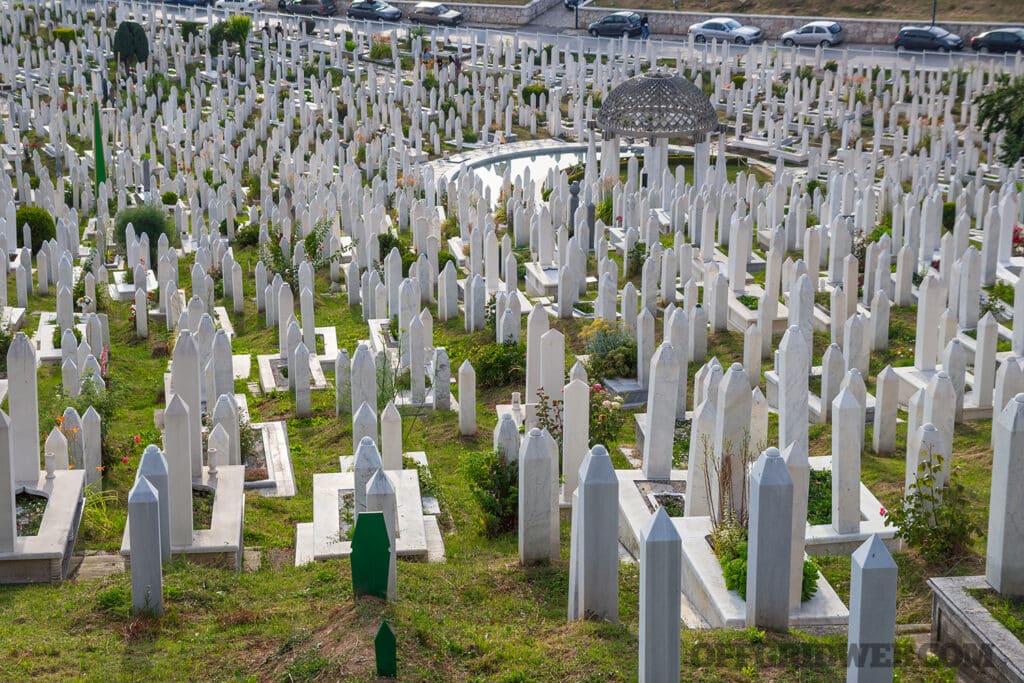
This cemetery in Sarajevo reflects a glimpse of the scale of death and destruction that impacted the area in the 1990s.
Were there specific events or incidents that made you realize the situation was escalating toward war?
Our old country, Yugoslavia, was a mix of different nationalities and religions. These differences were present in every part of society, including — for example — the police force. When people began leaving their jobs or fleeing places where they were in the minority, it was a clear sign of a serious problem. Nationality suddenly became more important than being right or wrong.
There was also a rewriting of history. Old monuments from World War II were destroyed and certain holidays were abandoned, all in the name of this new understanding of history following the fall of communism. While some of these changes made sense, the majority were simply used to heighten the already tense atmosphere between different groups. This led to a downward spiral of vigilantism and violence.
How did local authorities and government officials respond to the increasing instability?
The response varied from region to region. In areas where violence escalated quickly, government officials often didn’t have time to react properly. In other cases, local authorities even joined in the violence, reinforcing it rather than trying to stop it.
Of course, there were efforts to calm things down, but these were often too weak or obstructed to make a difference. Ultimately, those efforts failed.
How did neighboring regions or countries respond? Were they willing to help displaced people, or did they turn them away?
The response from the closest neighboring countries was complicated. They had their own problems and their own stakes in the conflict. Generally, they were involved in helping displaced people, but each country also helped their own “side” in the war, which had a significant influence on the conflict.
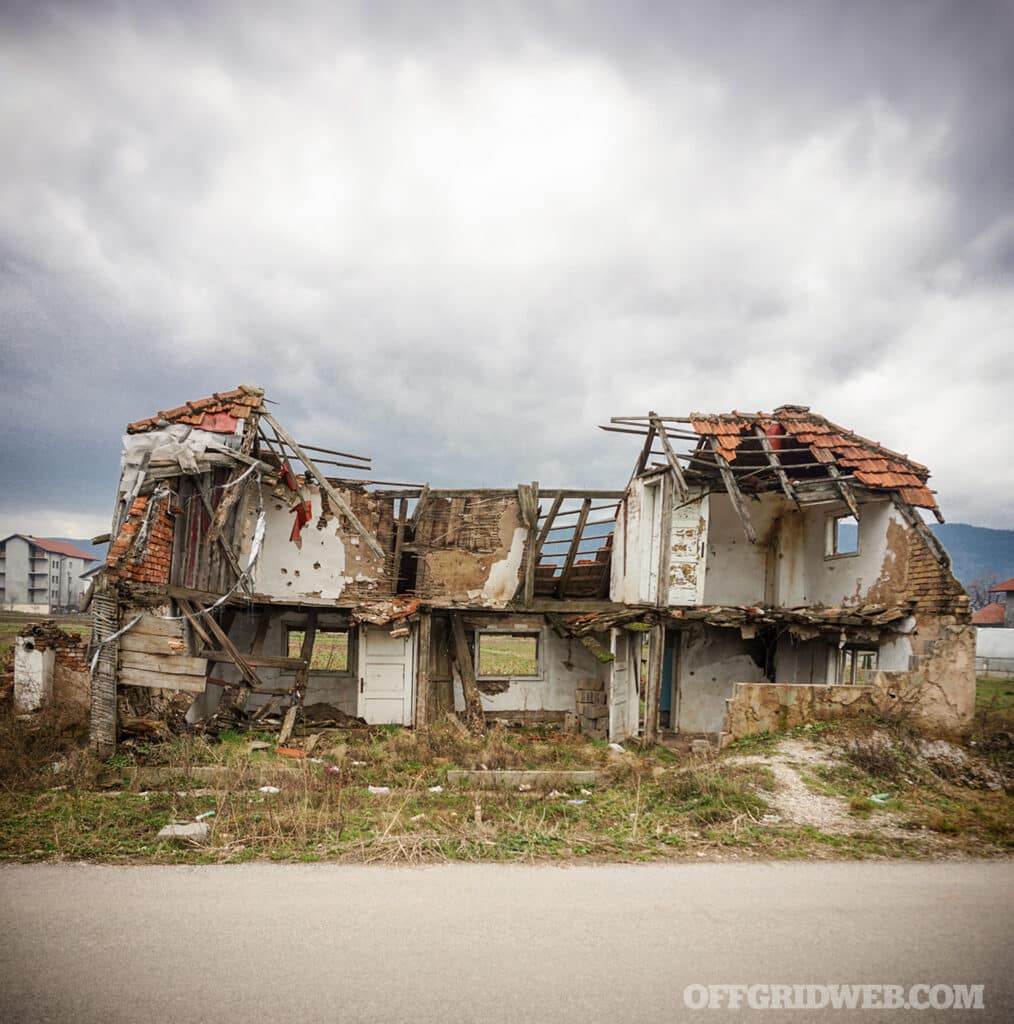
Above: A home near Sarajevo, Bosnia, destroyed during the Bosnian War that took place between 1992 and 1995.
What were the first visible signs of societal breakdown in your community?
There were many signs, especially when I look back on it now.
Economic problems such as inflation and shortages of certain goods were all visible before the war fully erupted. People also became more prone to violence because they saw that it worked. All of this was visible before the full-scale war broke out, but most of those who saw it back then failed to recognize the significance of these warning signs.
The most immediate sign of complete societal breakdown for me was when people realized that the normal system was gone. They recognized that there was no immediate punishment for stealing or killing because there was no functioning legal system anymore. More importantly, they realized that the normal system of law and order wasn’t coming back anytime soon.
This led to widespread looting, shooting, stealing from neighbors, and the rise of criminal organizations that filled the power vacuum. Those organized crime syndicates effectively replaced the old system of government, or at least worked within what remained of it, taking us from no rules at all to a semblance of loose rules. In some cases, several of these groups operated within the same city, each carving out their own slice of the pie.
How did the behavior and attitudes of your neighbors and friends change as the conflict approached?
If you're an average person with a normal family and kids, and suddenly your children have nothing to eat, you’ll do whatever it takes to feed them. Looting a shopping mall might be the “softest” step you take.
People adapted to the new reality, or they perished, just like in any other time in history. Especially in dense urban areas where there were more people than resources, people were quickly forced to find new ways to survive.
As a result, you couldn’t be sure who was friend or foe. Some people banded together with their families to be stronger, others joined military groups, and some became mercenaries in the worst sense of the word.
Were there any early indicators of military mobilization or armed groups forming in your area?
The disintegration of the old Yugoslav army and the fighting among different factions marked the beginning of the armed conflict. Initially, there were many groups — some might call them militias — who recruited people either voluntarily or by force. These groups varied greatly in terms of organization, equipment, and morality. Some were little more than well-armed gangs.
Nationwide, there was a ban on men of military age leaving the country. In reality, if you had connections or money — usually you needed both — you could avoid it. From this point on, the majority of people ended up being involved in some way.
What rumors and misinformation were spread during the early stages of the conflict? How did people react to them?
Hate and fear were rampant. One local singer, in an interview years after the war, said that if we had Facebook back then, the war might not have happened because we could have checked with people on the “other side” to see if they actually wanted to attack us.
While I'm not sure Facebook would have saved us, the point was that people didn’t have many sources of information, so rumors and misinformation spread like wildfire. The media on every side fueled hatred toward the “others.”
For example, there were news reports on state-run TV claiming that 50,000 soldiers were going to attack your city in two days, killing everyone in their path. Women, children, civilians, everyone. While atrocities did happen, and in some cases on a large scale (i.e., genocide), misinformation spread in a way that dehumanized others, even when that wasn’t the case.
At the same time, the media often portrayed the situation as better than it was. There was a period of time when they were repeatedly saying that everything would be fine and that talks were in progress.
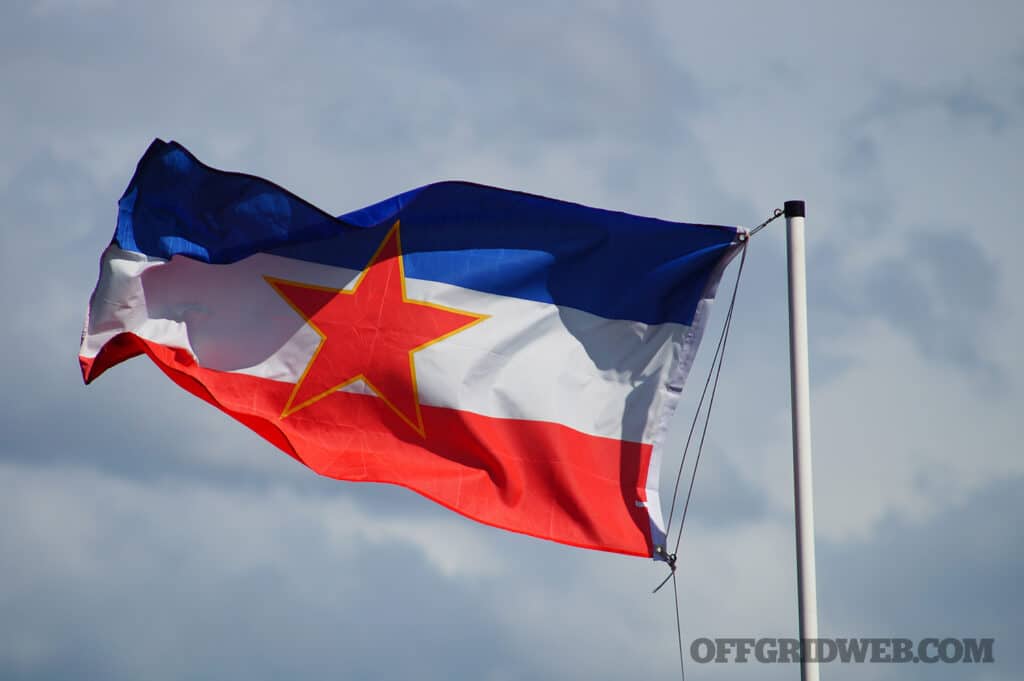
A red star on the flag of Yugoslavia represented the communist partisans led by Tito, who conducted successful guerrilla operations against the Axis powers during WWII. After the war, the victorious partisans were renamed the Yugoslav Army and engaged in mass executions of thousands of POWs and suspected fascist sympathizers.
What resources became hard to find or valuable? Were people able to develop alternatives?
The city I was in was under siege and cut off from the outside world, so pretty quickly everything became hard to find. Some things were more important than others — food, clean water, hygiene items, and medicines were at the top of the list, along with weapons (the availability of which changed as the conflict went on).
People adapted by “shrinking” their needs. When it came to food, it became basic flour and water recipes, maybe supplemented occasionally with local edible plants. There were times when better items, like MREs or canned food, were available on the black market, but you needed something to trade for them. If you couldn't obtain a resource through normal channels and you weren't willing to steal, you had to trade for it.
For the average person, it was bare minimum survival. Those with power and connections could find almost anything in small quantities. Let's say you wanted a beer in the middle of a civil war in a besieged city — you could probably get it, but it would cost you the equivalent of 200 beers in some other resource.
People ate less, relied on a few simple foods, and had poor or nonexistent hygiene. Medicine was rare and very expensive to trade for. As a result, many people died.
Small things that you usually don’t think about, like lighters, became incredibly valuable. A few months into the siege, lighters became a precious commodity. Even flints for lighters were highly sought after.
Did you see a rise in any specific types of crime? If so, how did people defend against it?
In the early days of chaos, crime was mostly opportunistic. It started with looting malls and stores, much like you see during natural disasters or riots. But soon it escalated to looting and stealing from those with known resources, like rich people or business owners. Folks who had stuff and couldn’t protect it got attacked.
Eventually, as organized crime groups crept in and took hold, crime became more structured. These groups dominated the black market, dictating prices, and trading gold and jewelry for small amounts of food.
Over time, crime transitioned from chaotic and random to more organized and predictable, though it was always dangerous for ordinary people. However, if you paid close attention, you could make sense of what was happening after the initial weeks of chaos.
What was the greatest threat to your survival during this time period, and how did you overcome it?
Violence was the greatest threat. It was a constant presence, though it varied in scale and organization. Perhaps an even greater threat, in a more silent way, was the combination of poor hygiene, inadequate nutrition, lack of medicine, and constant mental stress.
We can call it a poor quality of life. This combination took its toll, and many people died from it. The mental strain was particularly devastating, and some people simply stopped caring, or they gave up, became sick, and died.
For me, the key to overcoming these challenges was being part of a group that went through it all together. We had strength in numbers to deal with the violence, and we combined our knowledge to overcome other problems.
The support we provided each other, especially mentally during the hardest moments, was crucial. For me, that was and still is the “winning combination” for survival — a strong community.
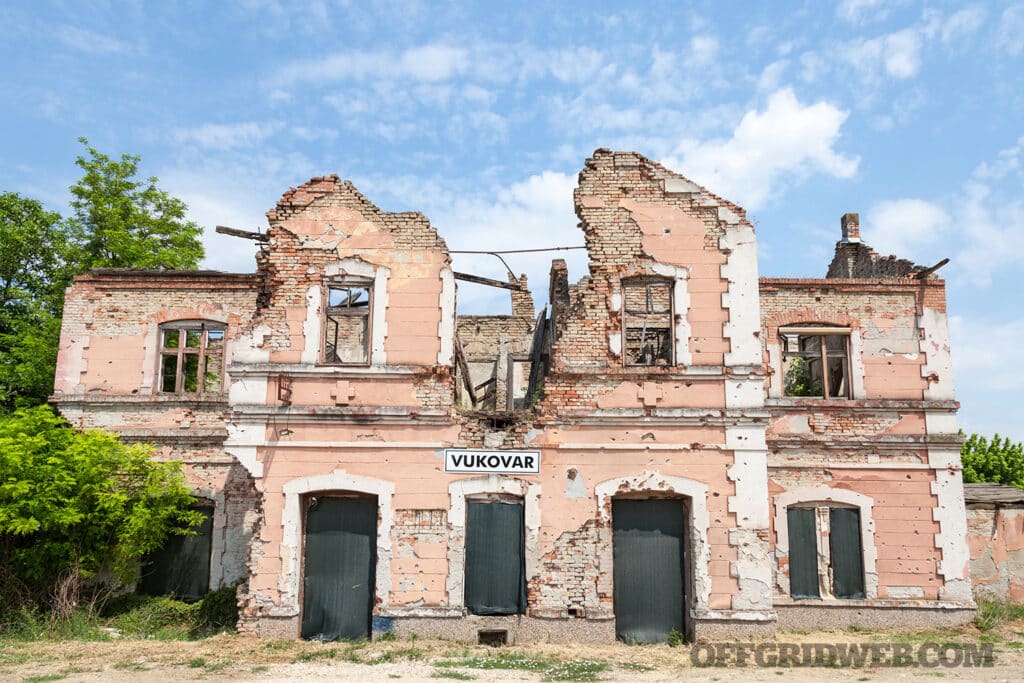
Above: More than 30 years later, the scars of war are still visible throughout the region. This train station was one of countless buildings almost completely destroyed in 1991 during an 87-day siege on the city of Vukovar, Croatia.
Were there any specific incidents of government or military action that marked a turning point toward full-scale conflict?
I believe the turning point was when military forces in some regions “took down” civilian structures and effectively imposed military rule, which wasn’t legal. Following that, civilian buildings and people became targets, either through direct action by military units or artillery bombardment. For most people, this marked the point of no return, as fear and horror became a normal part of life.
If you could go back in time, what's one lesson you wish you could teach your former self to make survival easier?
It’s hard to narrow it down to just one lesson, especially since I wasn’t a prepper when this all started, so I missed a lot of things and lessons. But if I had to choose one, it would be this: believe that it can happen to you. If you see the signs, don’t ignore them. Start preparing now, because this type of collapse can and will happen again.
Read More
Don’t miss essential survival insights—sign up for Recoil Offgrid's free newsletter today!
Check out our other publications on the web: Recoil | Gun Digest | Blade | RecoilTV | RECOILtv (YouTube)
Editor's Note: This article has been modified from its original version for the web.
The post Surviving Total Collapse: The Balkan War appeared first on RECOIL OFFGRID.
By: Nick Italiano
Title: Surviving Total Collapse: The Balkan War
Sourced From: www.offgridweb.com/survival/surviving-total-collapse-the-balkan-war/
Published Date: Sat, 19 Oct 2024 11:00:21 +0000
------------------------
Did you miss our previous article...
https://bushcrafttips.com/bushcraft-news/the-warriors-path-interview-with-rich-graham
 What is BushcraftSurvival SkillsToolsVideosBushcraft CampsBushcraft KitsBushcraft ProjectsPrivacy PolicyTerms And Conditions
What is BushcraftSurvival SkillsToolsVideosBushcraft CampsBushcraft KitsBushcraft ProjectsPrivacy PolicyTerms And Conditions
